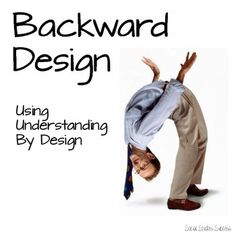Backward planning or backward mapping is a process that educators use to design learning experiences and instructional strategies to achieve specific learning goals.
Backward design begins with the objectives of a unit or course—what students are expected to learn and be able to do—and then proceeds “backward” to create lessons that achieve those desired goals. In most public schools, the educational goals of a course or unit will be a given state’s learning standards—i.e., concise, written descriptions of what students are expected to know and be able to do at a specific stage of their education.
The basic reason encouraging backward design is that starting with the end goal, rather than a starting with the first lesson chronologically delivered during a unit or course, helps teachers design a sequence of lessons, problems, projects, presentations, assignments, and assessments that result in students achieving the academic goals of a course or unit—that is, actually learning what they were expected to learn.
Backward design helps teachers structure courses and units that are focused on the goal (learning) rather than the process (teaching). Because “beginning with the end” is often a counterintuitive process, backward design gives educators a structure they can follow when creating a curriculum and planning their instructional process. Advocates of backward design would argue that the instructional process should serve the goals; the goals—and the results for students—should not be determined by the process.
Basic backward-design process forms:
- A teacher begins by reviewing the learning standards that students are expected to meet by the end of a course or grade level. In some cases, teachers will work together to create backward-designed units and courses.
- The teacher makes an index or list of the vital knowledge, skills, and concepts that students need to learn during a specific unit. In some cases, these academic expectations will be called learning objectives, among other terms.
- The teacher then designs a final test, assessment, or demonstration of learningthat students will complete to show that they have learned what they were expected to learn. The final assessment will measure whether and to what degree students have achieved the unit goals.
- The teacher then creates a series of lessons, projects, and supporting instructional strategies intended to progressively move student understanding and skill acquisition closer to the desired goals of the unit.
- The teacher then determines the formative-assessment strategiesthat will be used to check for understanding and progress over the duration of the unit (the term formative assessment refers to a various methods—from questioning techniques to quizzes—that teachers use to conduct in-process evaluations of student comprehension, learning needs, and academic progress during a lesson, unit, or course, often for the purposes of modifying lessons and teaching techniques to make them more effective). Advocates typically argue that formative assessment is integral to effective backward design because teachers need to know what students are or are not learning if they are going to help them achieve the goals of a unit.
- The teacher may then review and reflect on the prospective unit plan to determine if the design is likely to achieve the desired learning goals. Other teachers may also be asked to review the plan and provide constructive feedback that will help improve the overall design.
As a strategy for designing, planning, and sequencing curriculum and instruction, backward design is an attempt to ensure that students obtain the knowledge and skills they need to succeed in school, college, or the workplace. In other words, backward design helps educators create logical teaching progressions that move students toward achieving specific—and important—learning objectives. In general, strategies such as backward design are attempts to bring greater coherence to the education of students, such as to establish consistent learning goals for schools, teachers, and students that reflect the knowledge, skills, conceptual understanding, and work habits deemed to be most essential.
Backward design arose in tandem with the concept of learning standards, and it is widely viewed as a practical process for using standards to guide the development of a course, unit, or other learning experience. Like backward designs, learning standards are a way to promote greater consistency and commonality in what gets taught to students from state to state, school to school, grade to grade, and teacher to teacher. Before the advent of learning standards and other efforts to standardize public education, individual schools and teachers typically determined learning expectations in a given course, subject area, or grade level—a situation that can, in some cases, give rise to significant educational disparities.
